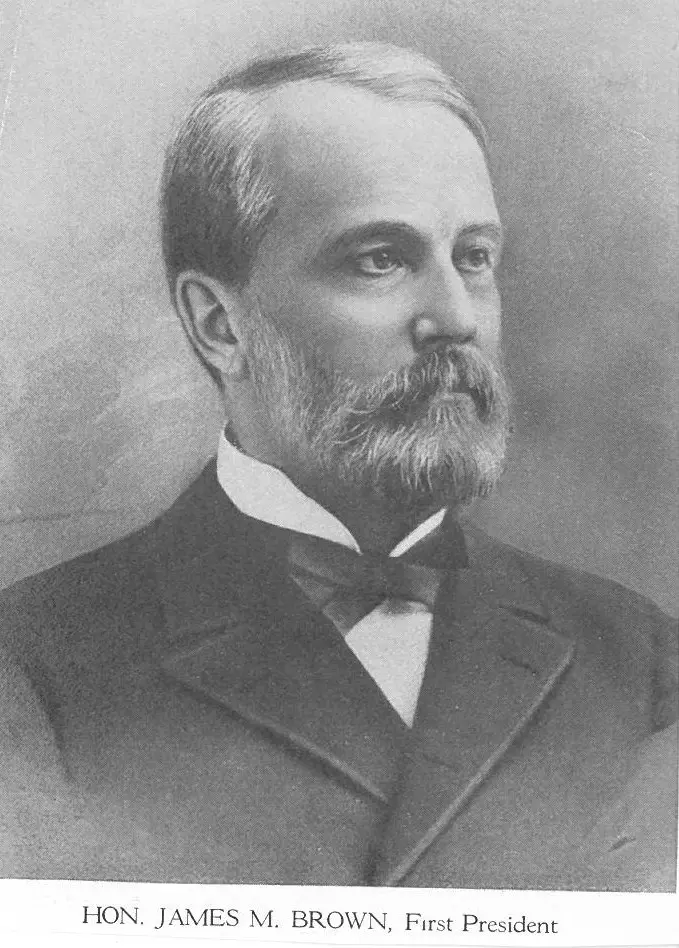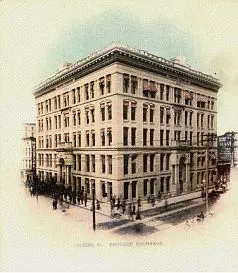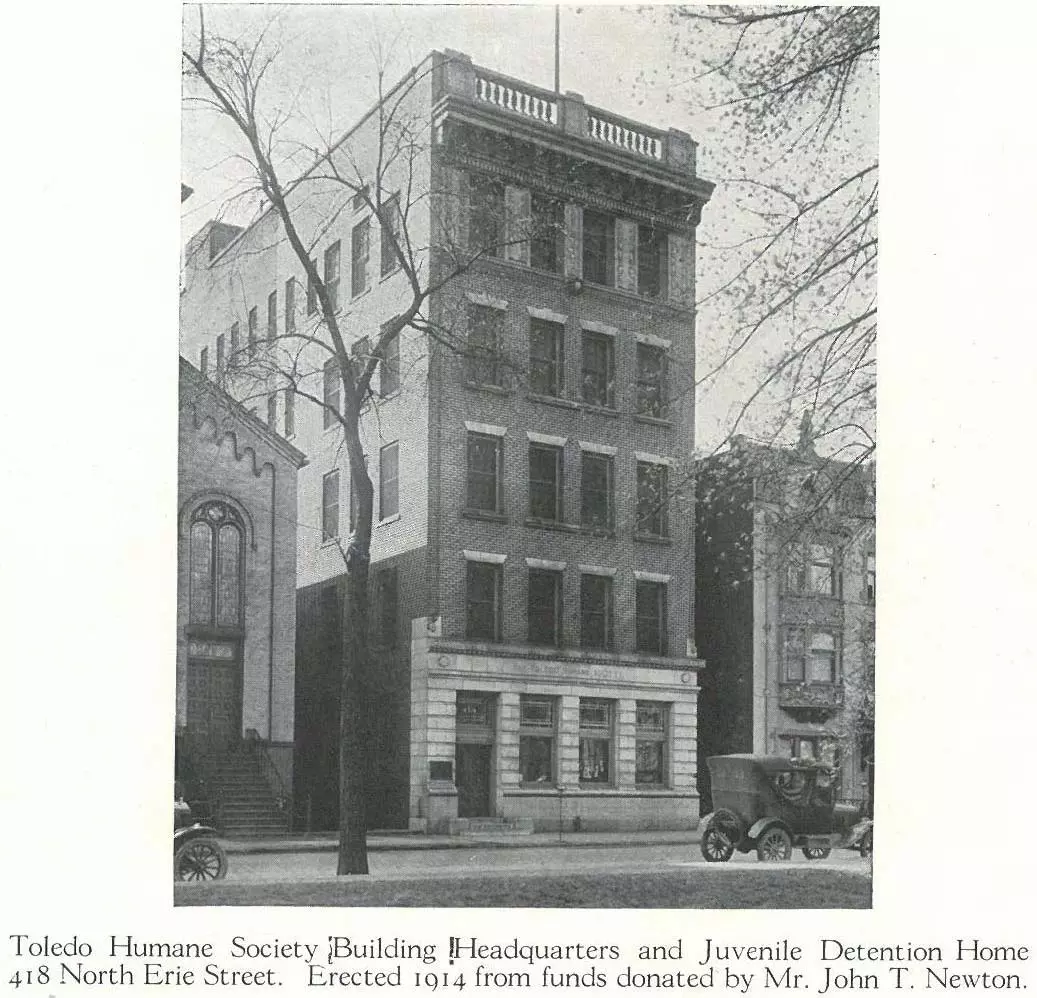by Arjun Sabharwal
The Toledo Humane Society formed on January 29, 1884 and incorporated on February 14, 1884 , following meetings held at the Richard Mott's Home and Toledo Produce Exchange in Downtown Toledo in December of 1883. A few prominent business and city leaders, including Merchants’ and Manufacturers’ Exchange, met to propose the formation of the Society for the Prevention of Cruelty to Children and Animals “to provide for the care and support of innocent children; for the protection of helpless children from the brutal-minded; for the care and comfort of aged parents; for over-worked, underfed and abused horses; and for the protection of all dumb animals.” (Toledo Blade, January 21, 1951). Although the society was the first formalized institution in Toledo to curb cruelty to children, women, and animals, this was by no means the first such attempt: English law in the 1820s have extended protection to animals and humans from cruelty. In the United States in 1866 and afterwards, New York’s Pioneer Society and the Massachusetts State Society have influenced legislation and the penal system to address and punish acts of cruelty. The Toledo Humane Society's first annual report for 1884 mentions an earlier society in Toledo, which formed shortly following the end of the Civil War but ceased operations shortly after its beginning.
 James M. Brown, first President of the Toledo Humane Society
James M. Brown, first President of the Toledo Humane Society
Their first president was James M. Brown whose leadership during the first twenty-five years has significantly shaped the organization's identity, missions, and respectable early accomplishments. As a trained lawyer familiar with the political process and a long-standing member and president of the American Humane Association, Brown has proposed laws to protect animals, children, and women from neglect and cruelty, and hold violators responsible and punishable with prison.Upon his death in 1909, his son Walter F. Brown presided over the society until his death in 1961. Otto Spangler was the third president, and Gary Willoughby II is currently the Executive Director.
The Society's first headquarters building was located on on Orange and St. Clair Streets, but by 1914 it proved to be too small for the expansion of its services under Walter Brown. The new building at 418 Erie Street (across from the Lucas County Court House) opened in 1914 with funds from John T. Newton, who was one of Toledo's prominent philanthropists also helping the Toledo Newsboys Association to get a permanent home in 1915.
Interestingly, the Erie St. building became the site of the Children's Division until it vacated this building in 1965. James M. Brown's role to secure a home for self-motivated runaway boys had been noted in other sources on the society's history. In 1918, the Animal Division Center on Wabash and South Streets opened. On December 15, 1981, the Toledo Humane Society opened its new facility at 1320 Indian Wood Circle in Arrowhead Park (Maumee).
The Toledo Humane Society has played an important role in Toledo since 1884, and its first twenty-five years of operation was particularly important in its self-identification as a social service and charitable organization. Society’s focus on curbing animal cruelty was, however just as important, given the lack of laws against animal abuse and the history of animal-related and other epidemics in this area. Efforts by the Toledo Humane Society to work with other important organizations in Toledo, such as Kiwanis, Rotary Club, and others demonstrated that the gravity of these problems justified a city-wide—if not wider—collaboration. During the Depression Era, Toledo was an important place for philanthropic activity to help the needy and other less fortunate people and animals suffering under inhumane conditions of an industrialized and commercialized environment of a city. While neglectful businesses have directly contributed to this problem, similar businesses have explored solution and funded the improvement of animal treatment and transportation throughout this region. Although there were obvious signs of effects on this problem by the participating organizations, the fact that the society is active today in the 21st century points out that the abuse of animals, children, and women (including their trafficking) continues today. The Humane Society represents the very shift in perspective on a more civil society in the latter half of the nineteenth century through its combined approach to curb cruelty against animals and children and its charitable activities and humanitarian visions.
Related documents:
A Brief History of the Toledo Humane Society (typescript), n.d. [PDF]
First Annual Report of the Toledo Humane Society, (1884) [PDF]
First Annual Report of the Toledo Humane Society (1893) [PDF]
The First Newsletter of the Toledo Humane Society, 1961 [PDF]
The Toledo Humane Society: It's A Friend In Need For All Types of Animals (1959) [PDF]
The Humane Society (A Toledo Evening Bee article about the formation of the society in 1884) [PDF]
The Men Who Made Toledo: James M. Brown and The Humane Society [PDF]
Reasons Why with House Bill proposed by Toledo Humane Society, February 11, 1890 [PDF]
Working bibliography
"The Humane Society: A Prominent Organization Effected Last Evening, Its Constitution and Bylaws--Elections of Officers." The Toledo Evening Bee, January 30 1884.
Association, American Humane. Report of the Proceedings of the Twenty-Second Annual Convention of the American Humane Association Washington, D. C., 1898.
Ewing, Ruth, ed. "James M. Brown." Humane Advocate, September 1909, 2.
Gunckel, John Elstner. Boyville; a History of Fifteen Years' Work among Newsboys. Toledo, Ohio,: The Toledo newsboys' association, 1905.
King, Frank I. "Toledo Newsboys' Home." The Rotarian, April 1915, 1.
Scribner, Harvey, and Association Western Historical. Memoirs of Lucas County and the City of Toledo, from the Earliest Historical Times Down to the Present, Including a Genealogical and Biographical Record of Representative Families [in English].
Madison, Wis.: Western Historical Association, 1910.
Society, Toledo Humane. "First Annual Report of the Toledo Humane Society for the Prevention of Cruelty against Animals and Children." 1884.
Stafford, Dorothy. "James M. Brown and the Humane Society." Toledo Blade, January 21 1951, 1, 4.
Toledo Humane, Society. Reasons Why the Bill to Enable Convicts to Assist in the Support of Their Wives and Children Should Pass [in English]. [Toledo, Ohio]: Toledo Humane Society, 1890.
Related
Sabharwal, Arjun. "City, Legacy, and Reform: The Beginnings of the Toledo Humane Society." Ohio History 125, no. 1 (2018): 47-69. doi:10.1353/ohh.2018.0003 https://muse.jhu.edu/.


